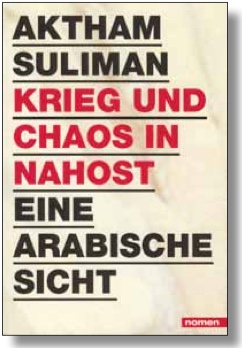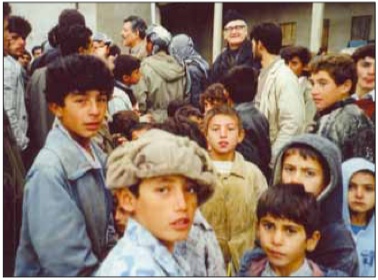“An era of peace, security, freedom and justice”?
“An era of peace, security, freedom and justice”?


To the book of Aktham Suliman “Krieg und Chaos in Nahost Eine arabische Perspektive” (War and Chaos in the Middle East. An Arab Perspective)
by Dieter Sprock
The recently deceased 41st President of the United States, George H. W. Bush, proclaimed a new world order in 1991 after the end of the Second Gulf War: “An era of peace, security, freedom and the rule of law.” The German-Syrian Middle East expert Aktham Suliman documents what has become of this in his book “War and Chaos in the Middle East. An Arab Perspective”.
Aktham Suliman was less than 20 years old at the end of 1989 when he came to Germany from Damascus to study computer science. When a few months later, on 2 August 1990, Iraqi tanks crossed the border to neighbouring Kuwait, it was a shock for him and the other young Arab students in Germany, although no one could have foreseen what a “harrowing and new type of war” would develop from it in the Middle East. It was the prelude to the Second Gulf War. (The first took place between 1980 and 1988 between Iraq and Iran.) Aktham Suliman changed his dicipline and studied journalism, political science and Islamic studies. For more than ten years he worked as a correspondent and office manager for the Arab news channel al-Jazeera in Germany, which he left in the summer of 2012 because it had developed into a propaganda channel in the service of the USA and NATO. Today he lives as a freelance author in Berlin.
The Second Gulf War and its consequences
Aktham Suliman sees his book, published in 2017, as “the curriculum vitae of death in the Middle East in the last quarter of the century from an Arab perspective”. What for the West was the liberation of Kuwait under the name “Operation Desert Storm” was for many in the Arab world a “death storm”, from which “the region between the Atlantic Ocean and the Persian Gulf” has not recovered to this day.
According to the “core thesis” of his book, the Second Gulf War marked the beginning of many later developments between the Arab-Islamic world and the West. He traces the development from the Second Gulf War, through 11 September 2001 and the “War on Terror”, the Iraq war 2003 and the “Arab Spring” 2011, through the emergence of the “Islamic State” (IS) to the Syrian and Libyan wars in detail and poses the question: “Why so much war and chaos? In doing so, he does not claim to present the Arab view, but only an Arab one, while conceding that there is also “the perceived commonness”. From an Arab perspective, the last 25 years were “not only historical developments and events, but rather fateful moments for people of flesh and blood”. He has dedicated his book to three Arab friends on behalf of millions of people killed since 1991.
Back to the Stone Age
The massive air raids on Iraq began on 17 January 1991 at 3:00 a.m. local time, after the USA had rejected several mediation attempts and offers by Saddam Hussain to withdraw troops from Kuwait. Hundreds of fighter planes and bombers flew “more than 1000 air raids with 1,400 tons of dropped bombs daily”. According to several sources, in just five weeks, a larger bomb load was dropped on Iraq “than during the entire Second World War”. On 24 February, the ground warfare began, and on 28 February, President George H. W. Bush announced the end of the war with the words: “Kuwait is liberated, Iraq’s army is defeated, we have scared away the Vietnam syndrome once and for all”. So was that the goal of the massive bombing of Iraq?
“Everything was bombed in Iraq,” writes Suliman, “power stations and water supplies, communications and port facilities, oil refineries and pipelines, railroads, connecting roads and bridges.” The convoy of Iraqi soldiers who had already capitulated and were on their way out of Kuwait was also bombed for hours.
According to Suliman, the “Stone Age Strategy” of the USA quickly gave the impression among the Arabs, even among Saddam Hussein’s opponents, that the West had destroyed Iraq “deliberately and maliciously” in order to set a “warning example” of military power in Mesopotamia. It ought to be a signal to the entire Arab world who is the boss now when it comes to “asserting political and economic interests” in the Middle East region.
Media propaganda
Suliman describes the fact that the USA relied on a UN resolution and was able to secure the support of more than 30 countries as a novelty in this war. This made the war an “absolutely legitimate war” in which two warring parties no longer faced each other, but a “military alliance of the good”, the “international community” and a rogue. The new term used: “military operation with UN mandate”.
Also new was the strong media presence in the Second Gulf War. The bombing of Baghdad could be followed-up on the screens in real time and should convince the whole world of the military fighting power of the USA. “It was the beginning of the age of live transmission of wars with coloured, moving images,” writes Suliman. It also was the beginning of a new era for war propaganda. With coloured and moving images, people all over the world were touched to tears before the war began and made to feel: “Something has to be done.” This is what the so-called “incubator lie” stands for, invented and spread for 10 million dollars by a New York PR company. According to the story, Iraqi soldiers in Kuwait City tore premature babies out of incubators and threw them onto the hard floor. An infamous lie, as it turned out later.
Why so much war and chaos in the Middle East?
At the end of the book, Aktham Suliman poses the question of the meaning and goal of Western action in the Middle East. “What exactly did the West want there in the 25 years between 1991 and 2016?”
For him, the “Third World War” broke out in January 1991, hidden behind the name “Second Gulf War”, “a war over concrete geostrategic interests such as natural resources, energy routes and spheres of influence – set off by the West, above all the USA”.
This World War, shifted to the Middle East, was not immediately visible to many in the West and elsewhere in the world. “Over long periods it was fought, on various occasions and on a confusingly broad and sometimes asymmetrical front, from Afghanistan in the Middle East to Libya in North Africa, via Iraq and Syria in the [former] Near East.
In his opinion, the Second Gulf War – the first stage of the “Third World War” – was to teach a lesson to enemies who were perhaps not yet visible at that time, prophylactically with many coalition partners and massive fireworks.
For the second stage, the “War on Terror”, so-called “academic scenarios” such as “The End of History” [Fukuyama] or “The Clash of Civilizations” [Huntington] had served as a kind of ideological preparation, accompaniment and justification of the war. These had contributed to an atmosphere in which a war could be capitalised as a legitimate instrument for spreading the Western system of values and politics and as a measure of self-defence against a terror network that originated predominantly from the Islamic cultural sphere, operating globally.
For Suliman the third stage includes emerging talk from the American side, immediately after the occupation of Afghanistan in 2001 and Iraq in 2003, of the formation of a “Greater Middle East Area”. During a visit to Tel Aviv, Condoleezza Rice announced that she wanted to sow “creative chaos” in the region, from which a “New Middle East” would emerge.
The fourth stage of the “Third World War” dawned, according to Suliman, with two major battles in Libya and Syria.
For him, the biggest losers among the Arabs are the Libyans, the Syrians and not least the Yemenis.
Since spring 2015, Yemen, which lies at the strategically important Bab al-Mandab (Gate of Tears), the Strait between the Red Sea and the Gulf of Aden, has been confronted with the intervention of a military alliance led by Saudi Arabia and supported by the USA, Great Britain and France.
Who actually is the adversary of the West?
The question about the adversary of the West in the “Third World War” is substantial for the comprehension of what happened in the Middle East between 1991 and 2016. A single glance at the world map immediately reveals the enemy around which the West wanted to stretch an Islamic belt such as the “Greater Middle East”. “And this at the price of renewed cooperation with radical groups, a mutilation of democratic thought back into ‘Stone Age’ and ‘Fata Morgana Democracy’, an economic crisis, an increased danger of terror for its own population and a migration of millions of refugees from Afghanistan, Iraq and Syria in all directions, including Europe.
The book presented can contribute much to a better understanding of today’s hazardous situation in the world. Reading it can protect against taking sides rash and emotional thus leading to further wars. A broad readership is to be wished therefore to this book. •
